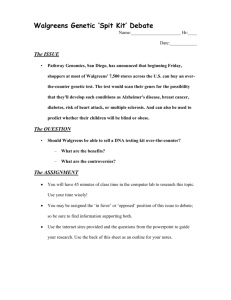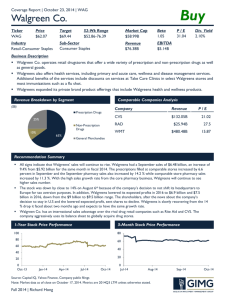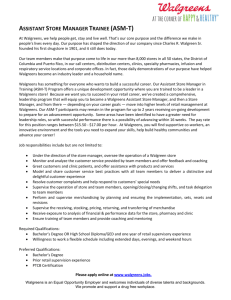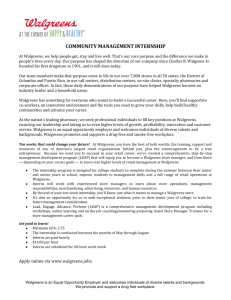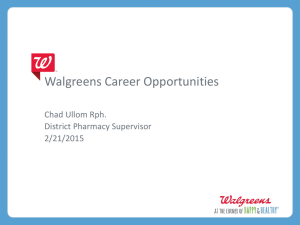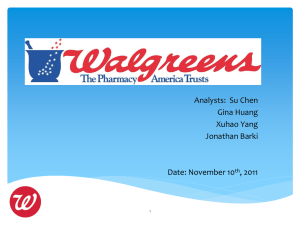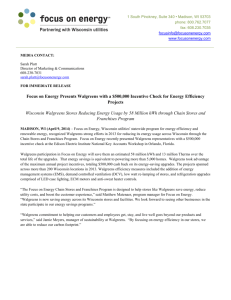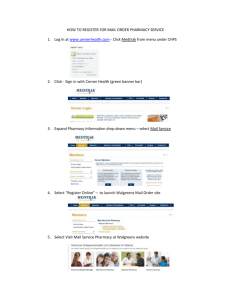Strategy Paper - Amazon Web Services
advertisement
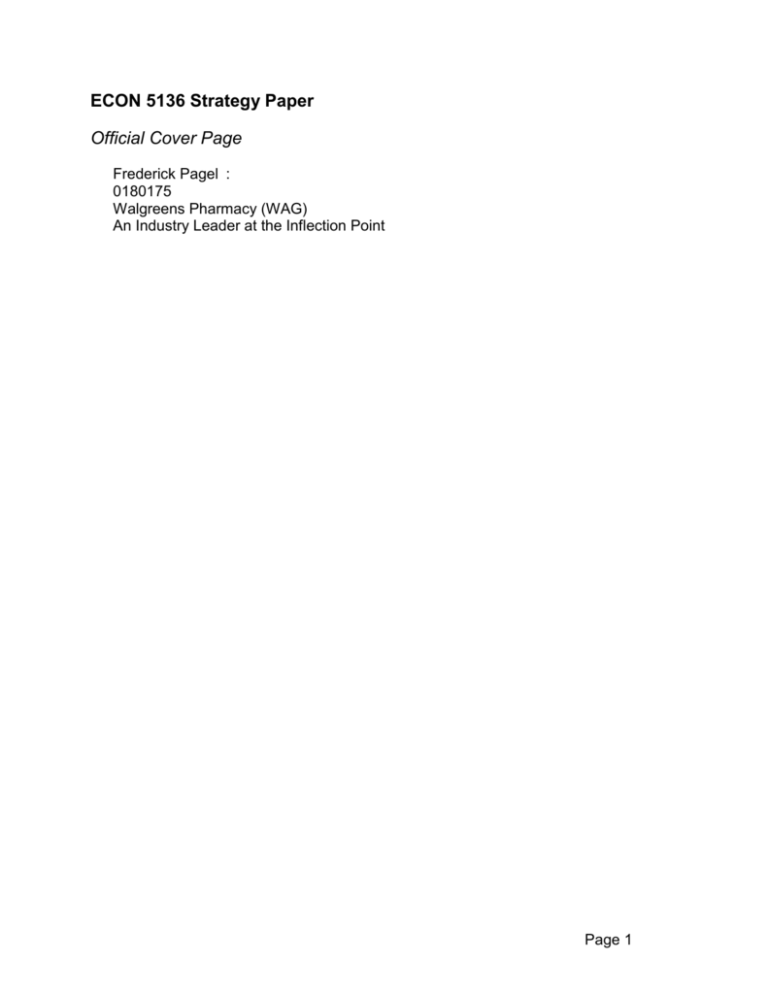
ECON 5136 Strategy Paper Official Cover Page Frederick Pagel : 0180175 Walgreens Pharmacy (WAG) An Industry Leader at the Inflection Point Page 1 The following report is an in-depth discussion of Walgreens Pharmacy with an analysis and assessment of the company’s strategic initiatives. Each strategy yields a direct purpose of diminishing the influence of a specific force from Porter’s 5-force Model as the supporting data culminates an outlook on the company’s future. COMPANY OVERVIEW Charles Walgreen of Chicago, Illinois, pioneered the first Walgreens in 1901, with corporate headquarters now located in Deerfield, Illinois. In the company’s 100-year reign as the prescription industry leader, Walgreens changed from war bonds, soda fountains, and restaurants to 24-hour store access, nationwide locations, easy-to-use online stores, and health care clinics. 6,400 stores now operate in all 50 states including Puerto Rico, with 30% open 24 hours. By 2010, Walgreen’s aspires to operate 7,000 stores nationwide and pave the way for the organic growth of 13,000 sites. As of December 2007, Walgreens employs 226,000 associates, hiring 25,000 in 2007 (WAG Annual Reports, 2007). According to the company’s 2007 annual reports, “Walgreens has been listed on: Fortune magazine’s Most Admired Companies in America list…ranked 44th on the Fortune 500 list of largest U.S-based companies…[and] ranked the leading online drugstore.” (WAG Annual Reports, 2007) In the past 2 years especially, Walgreens embarked on several ventures that will enable them to have first-mover advantage in the healthcare industry. CURRENT FINANCIAL INFORMATION In 2007, Walgreens increased net sales by 13.4% to $53.7 billion and increased net income by 16.6% to $2.04 billion. Long-term investments, which have consistently Page 2 increased by roughly $100 million dollars each year since 2004, reflect company profits (WAG Annual Reports, 2007). In the 2007 operating cash flow analysis, Walgreens yielded a yearly total over $23 million in deferred taxes that arose for tax relief in advance of tangible asset depreciated accounting expenses. While net cash flows in the operating sector dropped by $80 million in a single year production, sales, and delivery continue to expand. In the 2007 investment cash flow analysis, the company directed $6.4 billion toward short-term investments (auction rate securities) available for sale amounting to an accumulated $6.8 billion (WAG Annual Reports, 2007). With a staggering $1.8 billion spent on new additions in 2007, this perceived overextension by shareholders of the company’s business and intangible asset acquisition of $1.1 billion doubles the amount of cash used in the invested activities of 2006 (WAG Annual Reports, 2007). Employee termination and salary cuts yielded a 50% drop in proceeds received from company life-insurance policies. The $5.5 million proceeds of 2007 pale in comparison to the $10.7 million received only a year before. Walgreens spent $2.4 billion in investing activities during 2007, more than that of 2005 and 2006 combined (WAG Annual Reports, 2007). In the 2007 financial cash flow analysis, net proceeds were $850 million. With a $141 million debt payment, $1 billion in stock repurchases, $310 million cash dividends to shareholders, and a $214 million bank overdraft sum, Walgreen’s 2007 net cash used for financing activities rose to $626 million from 2006’s $413 million (WAG Annual Report, 2007). In summation, the initial cash and cash equivalents of 2007 declined from $920 Page 3 million in January to $255 million by the end of December resulting from the company’s overextension, and may result of losing their position as the industry leader in the near future (WAG Annual Reports, 2007) POWER OF BUYERS According to Porter, a buyer who has power “can always find an equivalent product, [then] play vendor against [one] another” (Porter, 2008). Consumers reap the benefits of an industry that pays for repeat business. In 2007, Walgreen’s pharmacists took 157,000 prescription transfer calls from neighboring competitors. (WAG Annual Reports, 2007) Mark Wagner, VP of Operations, announced that after reviewing the 2007 compiled transfer logs of the company, “72% of all prescription transfers [in 2007] are competitor coupon-related issues ” (WAG Annual Report, 2007) Walgreens remained static in their decision to offer any type of compensation to new customers or transferred prescriptions until October 2008. Walgreens customers receive an average of four prescriptions on a monthly basis from the pharmacy (WAG Annual Reports, 2007). With 65% of the sales revenue of the company coming from the pharmacy, Walgreens declines to bargain with out-ofpocket customers over price. Regardless of a climbing prescription drug-price trend, demand remains elastic because customers demand choices of similar, less expensive medications if authorized by their doctor. The amount of reimbursement Walgreens receives from Medicare, Medicaid, and Worker’s Compensation falls drastically, as incremental revenues from those sources decreases (Stewart, 2006). According to Lueck, “Medicare and Medicaid comprise 25 percent of the federal budget, and the Page 4 government cannot afford to spend at the current rate” (Lueck, 2008). In order to maintain relationships with customers, retail pharmacies resorted to buying sections of Medicare Part D insurance companies: AARP Walgreens vs. CVS Caremark (Caremark Rx Inc., 2007). RIVALRY AMONG EXISTING COMPETITORS From Porter’s point of view, “the degree to which rivalry drives down an industry’s profit potential depends, first on the intensity with which companies compete and, second, on the basis on which they compete” (Porter, 2008). Other than retail pharmacies, hospital pharmacies, mail-order pharmacies, internet pharmacies, international pharmacies, vitamin stores, and homeopathic treatment providers attempt to maintain market share in the healthcare industry (Lueck, 2008). Walgreens largest competitor, CVS Pharmacy, fell short of Walgreen’s sales revenues by $7 billion in 2007 (WAG Annual Report, 2007). Contrary to Porter’s model of rivalry, the healthcare industry is experiencing massive growth. Growth is not a force, but only a factor; and as Porter mentions, “high growth rate will not guarantee profitability if customers are powerful…” as stated in the last section (Porter, 2008). Tom Charland, CEO of Merchant Medicine, in his prophetic wisdom forecasted an “increased scarcity of physicians and midlevel practitioners in many markets and the increased use of pharmacists.” (Berman, 2007) This justifies the idea that most baby-boomers will spend several hours a week in doctor’s offices receiving treatment for maladies that require prescriptions. Because of meager prescription profits, customers gain little when switching from one pharmacy to another. Page 5 As Jeff Rein, VP of Walgreens, understands, “95% percent of our patients pay only the co-pay required by their insurance plans.” (WAG Annual Report, 2007) This removes Wal-Mart’s $4 prescription plan from the picture. POWER OF SUPPLIERS In Porter’s words, suppliers with power “can squeeze profitability out of an industry that is unable to pass on cost increases in its own prices.” (Porter, 2008) To make up for excessive inventory costs for new medication Walgreen’s must decrease labor hours and work more efficiently. For corporate executives in retail pharmacies like Mark Wagner of Walgreens, “the end solution is to cut costs…and the biggest cost in stores is payroll.” (Merrick, 2008) With manufacturers keeping new FDA-approved substitute (generic) medications at bay by creating expensive time-released versions of the original, retailers spend more money than ever before on shelf space (Merrick, 2008). The following demonstrates a sample of what Porter means by suppliers having power when they “offer products that are differentiated” (Porter, 2008). In March 2008, analysts at Citigroup Inc. announced, “AstraZeneca will have more time to market the product…Seroquel XR, a once-daily version of the [original] drug… slowly [converting] patients to the patent-protected drug before a generic version of Seroquel becomes available” (Merrick, 2008). Generic companies defending their rights to enter the market state brand name manufacturers received patents through "inequitable conduct" (Merrick, 2008). While CEO of Astra Zeneca, David Brennan remains “pleased with the court's decision to uphold [our] valid intellectual property," Page 6 healthcare companies like Walgreens suffer exorbitant inventory costs at lower vendor allowances for keeping both brand and newly arriving formulations (Merrick, 2008). STRATEGIC ANALYSIS The significance of this report’s title, “An Industry Leader at the Inflection Point”, speculates that Walgreens cannot remain myopically moving forward now that competitors are strategically placing modes of “creative destruction” in the healthcare industry. For example, Walgreens is following suit to retake power from buyers, a force seen in previous paragraphs, with a revolutionary prescription problem-processing center, POWER. These 24-hour call centers will automatically fix any third-party insurance rejection errors at all 6400 store locations, leaving pharmacists and pharmacy technicians more time to devote to prescription accuracy, efficiency, and patient consultation. Alan McNally, Walgreen’s new CEO as of October 22, 2008, justifies the use of POWER so “the company’s founding base of competitive advantage will bring vital market share, stockholder optimism, and customer sentiments of timeliness and prescription safety back to Walgreens” (WAG Annual Reports, 2008). Despite Walgreens’ ability to gain back market share by utilizing POWER, this evolution of problem-solving workflow is the company’s first major step in “creative destruction.” Since an estimated “25-30% of work in the pharmacy originates from processing and troubleshooting third-party claims”, Walgreens shows no sign of maintaining current hourly needs for technicians when POWER operations begin (Merrick, 2008). The excess reserves saved from this venture will allocate finances for greater stockholder dividends and ensure the company’s progressive movement into staying one-step Page 7 ahead of the competition (Merrick, 2008). According to the 2008 annual reports released in November, the salary expenditures saved from cutting technician hours will help support funding for the accumulated $1.4 billion dollar long-term debt in 2008 (WAG Annual Reports, 2008). Formerly discussed in the section, “Power of Suppiers”, Walgreens showed vulnerability to brand-name manufacturer’s new formulations marketed to physicians as more effective and safer than their FDA-approved generics. The county’s nation-wide recession that tumbled into a worldwide pandemic has been reason enough for many consumers to forgo reinstating their prescription insurance plans in 2009 and instead shop around for bargain generics (Lueck, 2008). Porter describes the country’s turmoil perfectly by announcing America is in the “Age of Anxiety,” as he reminds readers that in the US “restructuring destroys about 30 million jobs per year” (Porter, 2008), To combat consumer demand for lower cost prescriptions, Walgreens has aggressively marketed the Walgreens Drug Program in 2008. This discount program offers consumers the option of choosing from a list of 400 price-approved and quantityapproved generic medications at a 90-day supply for $12 (WAG Annual Reports, 2008). To attract customers to less expensive and more readily available generic medications, Walgreens built the discount program to show how much each customer can save while receiving a therapy that is exactly or similar to what their doctor prescribed. The only cost associated with this plan is a one-time $20 fee for using the service - pennies compared to the hundreds of dollars each month otherwise spent on prescription healthcare coverage. The idea of Walgreens creating healthcare clinics where customers can go and Page 8 receive treatment for common symptoms arose from competitor initiatives to capture a segment of the market not dominated by Walgreens. The purpose of this tactical approach was to lessen the force of rivalry in the industry. As of November 2008, Walgreens “operate[s] more than 600 health and wellness clinics in our stores and on employer worksites... [with] plans to expand to 800 sites by the end of fiscal 2009 (WAG Annual Reports, 2008). While data on this new mode of investment has not been conclusive or forecasted in expected yearly revenue, Walgreens intends on honing company expansion in this market to counter aggressively competitor initiatives. STRATEGIC ASSESSMENT The watershed of massive change for Walgreens culminated amidst what economists are calling a worldwide recession. Like all prosperous profit seeking companies, Walgreens managed to find ways to cut hours while increase efficiency that paved the way for higher shareholder dividends in 2008. CEO Alan McNally describes Walgreens’ strategy as “a successful triumph in a frantic market” leading on with a direct correlation of the yearly highlights to “an increase of $.11 in common share dividends for 2008” (WAG Annual Reports, 2008). Despite the company’s massive growth of long-term debt, the strategic positioning of POWER centers in high volume areas and payroll cuts began the combat against the emerging inflection point issues discussed. More than 1 million people enrolled in Walgreens discount card program in 2008. The company anticipates numbers to increase significantly at the beginning of Medicare reinstatement in January 2009 as members become more proactive in finding lower prescription costs. Constructed on gaining the business of customers upset with their Page 9 current prescription coverage, the discount care program cultivated an increase of gross market share to 17.6% of the retail prescription market in 2008. According to the new annual reports, in August 2008 Walgreens priced a $1.3 billion five-year bond offering to be “used in the repayment of short-term debt under its commercial paper program and general corporate purposes” (WAG Annual Reports, 2008). The bond’s primary purpose of financing the expansion of Walgreens’ Take Care Clinics around the country will reinforce goals of insatiable growth in the United States. As the beginning stages of these clinics develop, Walgreens will have a better idea of the market’s reaction. SUMMARY OF STRATEGY These market-enhancing strategies formulated by observing frustrated consumers over the years yield a successful and progressive outlook for Walgreens. While Walgreens’ presence in communities nationwide will continue to expand, the systems and processes which customers receive service will undoubtedly change. As services become increasingly automated and salaries are cut to supply overhead costs of the latest technologies and capital investments, Walgreens’ initiatives to solidify their position as the market leader will continue to be a tantalizing puzzle for the company’s corporate executives. Page 10 REFERENCES Berman, D. (2007, January 17). CVS Raises Caremark Bid, Pressuring Express Scripts. Wall Street Journal (Eastern Edition), p. A.4. Retrieved November 9, 2008, from Wall Street Journal database. (Document ID: 1195592291). Caremark Rx Inc.: Advisory Firm Urges Holders To Accept Offer From CVS. (2007, March 14). Wall Street Journal (Eastern Edition), p. A.12. Retrieved October 25, 2008, from Wall Street Journal database. (Document ID: 1232229641). Lueck, S. (2007, September 19). Politics & Economics: Democrats to Revisit Medicare Provisions. Wall Street Journal (Eastern Edition), p.A.12. Retrieved October 23, 2008, from Wall Street Journal database. (Document ID: 1337919191). Merrick, A. (2008, March 19). How Walgreen Changed Its Prescription for Growth. Wall Street Journal (Eastern Edition), p. B.1. Retrieved October 20, 2008, from Wall Street Journal database. (Document ID: 1448083011). Merrick, A. (2008, October 9). Walgreen Abandons Bid for Longs; Drug Chain Cites Weak Economy, Withdraws $2.7 Billion Offer. Wall Street Journal (Eastern Edition), p. B.1. Retrieved November 9, 2008, from Wall Street Journal database. (Document ID: 1570234871). Stewart, J. (2006, November 8). Common Sense: Letdown Over Deal By CVS, Caremark Offers Opportunity. Wall Street Journal (Eastern Edition), p. D.2. Retrieved November 9, 2008, from Wall Street Journal database. (Document ID: 1158307411). Porter, Michael E. (2008. Jan) “The Five Competitive Forces that Shape Strategy.” Harvard Business Review. Porter, Michael E. (2008.Nov) “Why America Needs an Economic Strategy” Business Week Walgreens Annual Reports, The (2007, Dec 31). Questions and Answers for Shareholders. Retrieved October 10, from Walgreens Co. Website: http://files.shareholder.com/downloads/WAG/460812286x0x147120/C3FF93FD-4E51-4F5A94FD-C0D058A9A911/Walgreen_AR_07.pdf Walgreens Annual Reports, The (2007, Dec 31). Management’s Discussion and Analysis of Results of Operations and Financial Condition. Retrieved October 10, from Walgreens Co. Website: http://files.shareholder.com/downloads/WAG/460812286x0x147120/C3FF93FD-4E51-4F5A94FD-C0D058A9A911/Walgreen_AR_07.pdf Page 11
